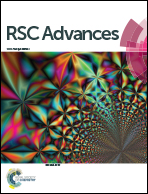A tungsten carbide/iron sulfide/FePt nanocomposite supported on nitrogen-doped carbon as an efficient electrocatalyst for oxygen reduction reaction
Abstract
The development of multi-component electrocatalysts offers great promise to enhance catalytic performance for the oxygen reduction reaction (ORR) of fuel cells. Herein, we report a novel hybrid material consisting of multiple components of tungsten carbide (WC), iron sulfide (FeS), FePt and nitrogen-doped carbon (NC), i.e. WC/FeS/FePt/NC hybrid architecture, as a high-performance electrocatalyst for the ORR. Due to the attractive multiple promoting effects from these components, the present Pt-based electrocatalyst exhibits an excellent mass activity of 317 mA mg−1 Pt (at 0.9 V vs. RHE), which is about 2.5 times as high as that of commercial Pt/C catalyst (125 mA mg−1 Pt). Moreover, superior durability in acidic electrolyte of the WC/FeS/FePt/NC is also demonstrated for the ORR. Importantly, this work provides a new approach for the design of high-performance ORR electrocatalysts by integrating the promoting effects of multiple components (especially for carbides and sulphides) on noble metals, which presents promising potential application for fuel cells.


 Please wait while we load your content...
Please wait while we load your content...